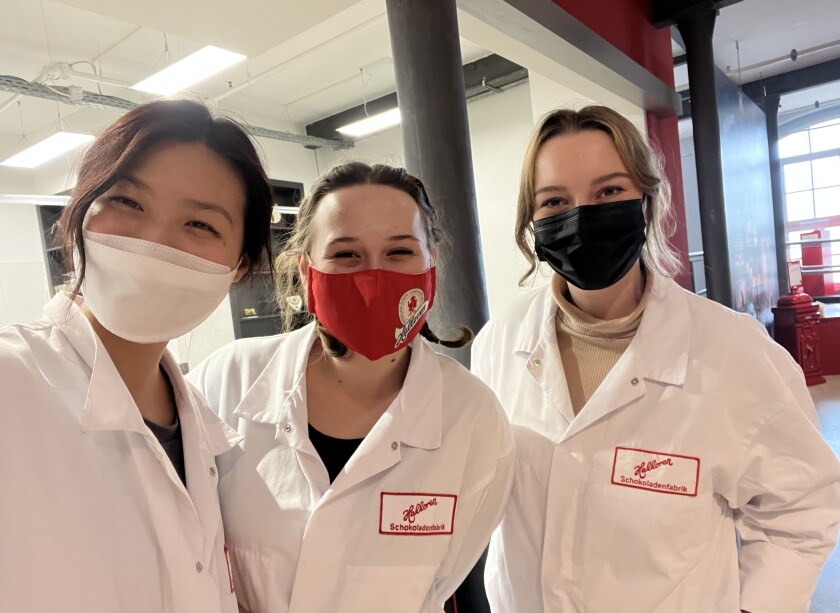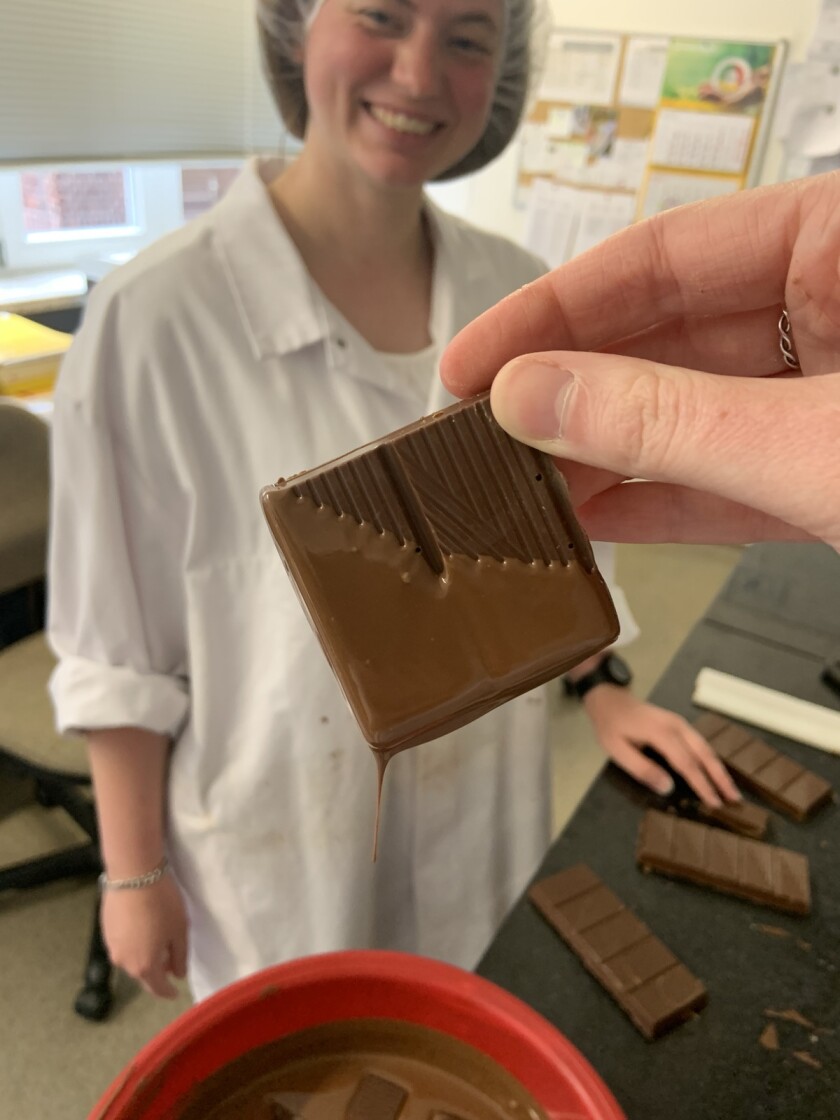BYU food science majors Carolyn Chen, Shayden Smith, Janece Nufer, and Erin Caswell put their wisdom to work when they interned at Halloren—the oldest chocolate factory in Germany
BYU food science majors Carolyn Chen (‘23), Shayden Smith (‘23), Janece Nufer ('23), and Erin Caswell ('22) experienced a world of pure imagination when they interned at the Delitzsche and Halloren chocolate factories. While there, the students put wisdom to work in the chocolate development process.
The students began their work on the production line alongside local factory workers to get a feel for the machines and to understand how certain products behaved. However, they spent most of their time developing new filling and flavor combinations in the product development lab. They tested which flavors worked well together and how to make the recipes function properly on the machines. “A client will say, ‘This is what I want in a chocolate bar,’ and then we’ll try to recreate that,” explains Chen.

An average day in the product development lab started at 6:30 a.m., drying the chocolate molds from the day before to ensure no residual moisture will interfere with the chocolate. Next, the interns began the lengthy tempering process—repeatedly heating and cooling chocolate to stabilize the crystallization of the cocoa butter fats. Properly tempered chocolate maintains a glossy finish and satisfying “snap” upon breaking, whereas incorrectly tempered chocolate can result in a crumbly texture and a molted, almost marble-like finish.
“The correct tempering temperature is very important and changes based on the type of chocolate and the ingredients,” Smith says. “A lot of our time in the lab was spent trying to find the right temperature balance before and after we added the ingredients to ensure that the chocolate would set properly.”
Once the area was prepped, the students started the workshopping process by listing available ingredients and flavorings. Then, they were ready to get creative and come up with different flavor combinations, keeping in mind the differences between German and American flavor palettes.
“German flavor profiles are really different than America for candies,” explains Smith. For example, while American consumers favor peanuts and almonds, Germans prefer hazelnuts. Fruit fillings and fondant bases are also very popular in the region, while less common in the US. “We had a lot of comments where [admin] would say, ‘Oh, this tastes too American. This is good, but it’s not Germany.’”
After brainstorming, the students scaled down their recipes and made 20 samples of each flavor combination. They took turns making samples, cleaning the area, tasting each other’s samples, and implementing the necessary adjustments. These samples were used in focus groups and additional research, with the potential of making their way to distribution.
“I’m really proud of some of the products we made and that one was approved to be produced. And they’re pitching it to different stores at the moment,” says Caswell, who helped produce a pumpkin spice “thin,” which features a thin piece of flavored fondant with a chocolate coating.

In addition to their product development work, the students had the opportunity to perform quality checks, create visual instruction videos for factory workers, carry out FDA regulation research, and lead a chocolate-making class at the adjacent Halloren museum. In most cases, the students worked independently—which proved to be an exciting opportunity, despite some of the intuition and practice needed to work around the language barrier.
“Not many people were able to communicate very fluently [with us] . . . by the end we had like 20 words we could say, and ten of them were ingredient words,” Smith laughs, recalling her experience. “For the most part, they’d send us a Google translated email and just be like, here’s your instructions, go nuts.” Each student expressed gratitude for the opportunities their generous travel grant provided.
“An internship gives you the experience and exposure you need to really understand the business world,” says Caswell. “You have to know how to work within a company, and it makes you think about things that you don't consider in the classroom.”
Caswell had heard about the Halloren internship from food science students who had previously participated in the experience. From there, a BYU professor put her in contact with Darren Ehlert, a BYU alumnus and CEO of the Delitzscher Schokolandenfabrik, Halloren Schokoladenfabrik, and Bouchard chocolate group. It was only a matter of time before Caswell, Nufer, Smith, and Chen were working and living in Germany.
Each student emphasized the importance of networking with other students and professors to learn more about valuable internship opportunities. “Talk to your professors—they know more than you do, they have connections you don’t have, and they can help set you up for success,” Caswell says. “If you get to know your professors really well, you’ll understand better how they can help you move forward. You’ll have the support of BYU and your department behind you.”